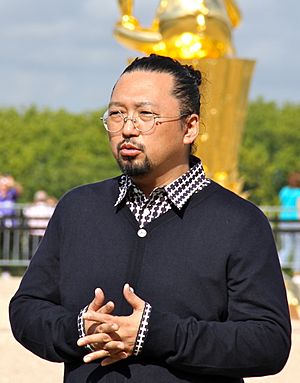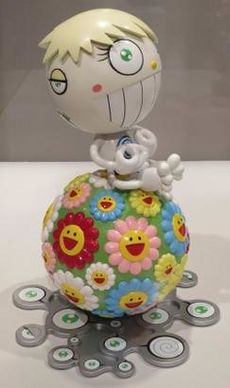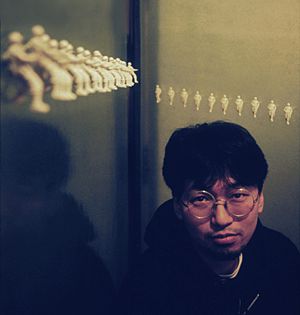Takashi Murakami facts for kids
Quick facts for kids
Takashi Murakami
|
|
|---|---|

Murakami at the Palace of Versailles 2010
|
|
| Born | February 1, 1962 Tokyo, Japan
|
| Nationality | Japanese |
| Education | Tokyo University of the Arts |
| Known for | Contemporary art |
| Movement | Superflat |
| Awards | Japanese Fine Arts |
Takashi Murakami (村上 隆, Murakami Takashi, born February 1, 1962) is a famous Japanese artist. He creates both fine art, like paintings and sculptures, and commercial art, such as fashion and animation. He is known for mixing "high art" (like museum pieces) with "low art" (like cartoons and merchandise). His art is inspired by traditional Japanese art and modern Japanese culture after World War II.
Murakami started and leads Kaikai Kiki Co., Ltd. This company helps manage other young artists. He also created and ran an art fair called Geisai for many years.
Contents
Life and Art Journey
Early Life and Studies
Takashi Murakami was born and grew up in Tokyo, Japan. When he was young, he loved anime and manga (Japanese cartoons and comics). He hoped to work in the animation world. He went to Tokyo University of the Arts to learn drawing skills.
He ended up studying Nihonga, which is a traditional Japanese painting style. He earned his master's degree in 1988. Even though he got a Ph.D. in Nihonga, he felt that this art world was too closed off. He then started looking into newer art styles and ways to create art.
Murakami felt that modern Japanese art was just copying Western styles. So, many of his early artworks were like social comments or jokes. He created his own popular character called "Mr. DOB." This character changed over time and became a kind of self-portrait. It was one of many repeating ideas in his art.
Time in New York
In 1994, Murakami went to New York City for a year. He was part of a special art program. There, he was inspired by Western artists like Jeff Koons. He set up a small studio, which later became part of his company, Kaikai Kiki. When he returned to Japan, he developed his main art ideas. He started showing his work in big art galleries in Europe and America.
Understanding Superflat
In 2000, Murakami shared his "Superflat" idea. He explained it in a book for an art show he organized. This idea suggests that Japanese art, from old paintings to manga and anime, often looks flat and two-dimensional. This is different from Western art, which often focuses on depth.
Superflat also talks about Japanese society after the war. Murakami believes that differences between social classes and tastes have "flattened out." This means there's less difference between "high" art and "low" popular culture. This idea helped explain his art. He also organized other shows to introduce Japan's creative culture to the world.
Murakami's art often takes things from "low" culture, like cartoons, and shows them in the "high-art" world. Then, he makes his "high-art" pieces into things like plush toys and T-shirts. This makes them more affordable and available to everyone.
His Art Studio: Kaikai Kiki
In 1996, Murakami started his art workshop called Hiropon Factory. He wanted to create bigger artworks using many different materials. In 2001, this workshop became a company called Kaikai Kiki Co., Ltd.
The name "Kaikai Kiki" means "brave, strong, and sensitive." It was a phrase used long ago to describe Japanese paintings. Kaikai Kiki helps Murakami with his art projects. It also helps manage the careers of younger artists. The company organizes art shows, makes and sells merchandise, and runs the Geisai art fair.
Murakami has achieved success around the world. Now, he focuses on helping new Japanese artists. He wants to build a strong art market in Japan. Kaikai Kiki has art galleries in Tokyo, including Kaikai Kiki Gallery and Hidari Zingaro. These galleries show art by Murakami and other artists.
Working with Others
Murakami has worked with many famous people and brands.
- Louis Vuitton: In 2002, he started working with the fashion brand Louis Vuitton. He designed artwork for their handbags, which became very popular. This made him famous for mixing high art with commercial products.
- Kanye West: In 2007, Murakami designed the cover art for rapper Kanye West's album Graduation. He also directed an animated music video for West's song "Good Morning." He later used these images in his own paintings and sculptures.
- Pharrell Williams: In 2009, music producer Pharrell Williams and Murakami created a sculpture together.
- Kirsten Dunst: In 2009, Murakami and McG directed a short film called Akihabara Majokko Princess. It featured actress Kirsten Dunst singing in Tokyo.
- Hatsune Miku: In 2014, Murakami made a music video for a remix of the Hatsune Miku song "Last Night, Good Night (Re:Dialed)."
- Vans: In 2015, he worked with Vans on a collection of shoes, clothes, and skateboard decks. These items featured his skull and flower designs.
- Virgil Abloh: In 2018, Murakami collaborated with fashion designer Virgil Abloh on a series of artworks.
- Billie Eilish: In 2019, Murakami directed and animated a music video for Billie Eilish's song "You Should See Me in a Crown." The video took eight months to make and featured an animated Eilish turning into a spider-like monster.
- J Balvin: In 2020, J Balvin's album Colores featured cover designs and artwork by Murakami.
- Supreme: Also in 2020, Supreme released a T-shirt with Murakami's artwork. All the money from sales went to help young people and families facing homelessness.
- Lewis Hamilton: In 2022, Murakami worked with Sir Lewis Hamilton for his '+44' fashion line. He also designed Hamilton's helmet for the 2022 Japanese Grand Prix.
Recent Work
From 2007 to 2009, Murakami had a big art show called ©Murakami. It traveled to museums in Los Angeles, New York, Frankfurt, and Spain. The show gained a lot of attention because it included a working Louis Vuitton store as part of the art.
In 2008, Time magazine named Murakami one of the "100 Most Influential People." He was the only visual artist on the list. In 2010, he became the first Japanese artist to show his work at the Palace of Versailles in France. He filled 15 rooms and the park with his sculptures, paintings, and lamps.
In 2011, Google featured a doodle by Murakami for the First Day of Summer. In 2012, he had an exhibition in Qatar called Murakami-Ego. It included a 100-meter-long painting showing the suffering of Japanese people after the Fukushima Daiichi nuclear disaster.
In 2013, Murakami's first full-length film, Jellyfish Eyes, was released in Japan. It's a live-action movie with computer-generated characters he designed.
Art Style
Murakami's art uses many different types of materials. It is often called "superflat." His work is known for its bright colors and smooth, shiny surfaces. He uses ideas from both traditional and popular Japanese culture. Some of his most famous repeating images are smiling flowers, Mr. DOB, mushrooms, skulls, and Buddhist symbols.
One of his well-known pieces, 'Hiropon', shows his interest in otaku culture (a Japanese term for people with intense hobbies, often related to anime and manga). Murakami once said that his smiling flowers represent "hidden, mixed feelings and the shared pain of Japanese people" after the Hiroshima and Nagasaki bombings in 1945. Besides large paintings, he also makes sculptures, balloons, wallpaper art, animated works, prints, posters, and various merchandise.
His Art Strategy

Murakami felt that Japan didn't have a strong art market after World War II. So, he decided to become famous in the Western art world first. Then, he would bring his art back to Japan to create a new kind of art market there.
To make art that was truly Japanese but also popular worldwide, he looked for what made Japan unique. He focused on Japan's "low" culture, especially anime, manga, and otaku culture. His art style, with its cute but sometimes strange anime-like characters, bright colors, and shiny surfaces, came from this idea. His fun Cosmos Ball from 2000 is a good example of this.
Art Value
Murakami's art is very popular. For example, his sculpture Hiropon (1997), which is over 7 feet tall, sold for $427,500 in 2002. Another sculpture, Miss ko2 (1996), sold for $567,500 in 2003. In 2008, his anime-inspired sculpture My Lonesome Cowboy (1998) sold for $15.2 million. This made it his most valuable piece. Murakami's total wealth is estimated to be around $100 million, and his artworks continue to increase in value.
Geisai Art Fair
From 2002 to 2014, Murakami organized a special art fair called Geisai. It happened once a year in Japan and sometimes in other cities like Taipei or Miami. Instead of having art galleries choose artists, Geisai let artists set up their own booths. They could talk directly with people who wanted to buy their art.
NFTs
Murakami started working with NFTs (Non-Fungible Tokens) in April 2021. His first NFT project, "Murakami.Flowers," was paused because he felt he didn't know enough about NFTs. He started thinking about NFTs because of money problems during the start of the COVID-19 pandemic. In November 2021, he worked with the Nike-owned company RTFKT Studios on their CloneX avatar projects. In January 2022, he announced that he would continue working on "Murakami.Flowers."
Books About Takashi Murakami
- Murakami, Takashi "Geijutsu Kigyoron" ISBN: 978-4-344-01178-6
- Murakami, Takashi "Geijutsu Tosoron" ISBN: 978-4-344-01912-6
- Murakami, Takashi "Summon Monsters? Open The Door? Heal? Or Die?" ISBN: 978-4-939148-03-3
- Murakami, Takashi "Superflat" ISBN: 978-4-944079-20-9
- Murakami, Takashi "Little Boy: The Arts of Japan's Exploding Subculture" ISBN: 978-0-300-10285-7
- Cruz, Amanda/Friis-Hansen, Dana/Matsui, Midori "Takashi Murakami: The Meaning of the Nonsense of the Meaning" ISBN: 978-0-8109-6702-1
- Schimmel, Paul "©Murakami" ISBN: 978-0-8478-3003-9
- Le Bon, Laurent "Murakami Versailles" ISBN: 978-2-915173-72-7
Exhibitions
1989
- Exhibition L'Espoir: Takashi Murakami, Galerie Ginza Surugadai, Tokyo
- New Works, Café Tiens!, Tokyo
1991
- Art Gallery at Tokyo National University of Fine Arts and Music, Tokyo
- Galerie Aoi, Osaka, Japan
- One Night Exhibition, August 23 Röntgen Kunst Institut, Tokyo
- I Am Against Being For It Galerie Aries, Tokyo
1993
- A Very Merry Unbirthday!, Hiroshima City Museum of Contemporary Art, Hiroshima, Japan
- Gallery Nasubi, Tokyo
- A Romantic Evening, Gallery Cellar, Nagoya, Japan 1992
- Wild Wild, Röntgen Kunst Institut, Tokyo
- NICAF'92, Shirashi Contemporary Art Inc., Yokohama, Japan
1994
- Fujisan, Gallery Koto, Okayama, Japan
- Which is tomorrow? - Fall in love -, SCAI The Bathhouse, Shiraishi Contemporary Art, Inc., Tokyo
- Azami Kikyo, Ominaeshi, Gallery Aoi, Osaka, Japan
- A Romantic Evening, Gallery Cellar, Nagoya, Japan
1995
- Galerie Emmanuel Perrotin, Paris
- NIJI (Rainbow), Gallery Koto, Okayama, Japan
- Crasy Z, SCAI The Bathhouse, Tokyo
- Mr. Doomsday Balloon, Yngtingagatan 1, Stockholm, Sweden
1996
- 727, Tomio Koyama Gallery, Tokyo
- 727, Aoi Gallery Osaka, Japan
- Feature Inc., New York
- Gavin Brown's Enterprise, New York
- Galerie Koto, Okayama, Japan
- Konnichiwa, Mr. DOB, Kirin Art Plaza, Osaka, Japan
- A Very Merry Unbirthday, To You, To Me!, Ginza Komatsu, Tokyo
1997
- Galerie Emmanuel Perrotin, Paris
- Blum & Poe Gallery, Santa Monica, California
- Galerie Koto, Okayama, Japan
- The Other Side of a Flash of Light, HAP Art Space, Hiroshima, Japan
- New York, Feature, Murakami: Hiropon, Project ko2
1998
- Hiropon Project KoKo_Pity Sakurako Jet Airplane Nos. 1-6, Feature Inc., New York
- Back Beat : Super Flat, Tomio Koyama Gallery, Tokyo
- My Lonesome Cowboy, Blum & Poe Gallery, Santa Monica, California
- Moreover, DOB raises his hand, Sagacho bis, Tokyo
1999
- DOB in the strange forest, Nagoya Parco Gallery, Japan
- Patron, Marunuma Art Park Gallery, Japan
- Second Mission PROJECT KO2, Hiropon Factory, Japan
- Dob's Adventures in Wonderland, Parco Gallery, Tokyo
- The Meaning of the Nonsense of the Meaning, Center for Curatorial Studies Museum, Bart College, New York
- Superflat, Marianne Boesky Gallery, New York
- Love & DOB, Gallery KOTO, Okayama, Japan
2000
- 727 Blum & Poe Gallery, Santa Monica, California
- Second mission Project KO2, P.S.1 Contemporary Art Center, New York
- Kaikai Kiki: Superflat, Issey Miyake for Men, Tokyo
2001
- Wink, Grand Central Station, New York
- Mushroom, Marianne Boesky Gallery, New York
- KaiKai KiKi, Galerie Emmanuel Perrotin, Paris
- Summon monsters? open the door? heal? or die?, Museum of Contemporary Art Tokyo, Tokyo
- Takashi Murakami: Made in Japan, Museum of Fine Arts, Boston, USA
2002
- Kawaii, Fondation Cartier pour l'art contemporain, Paris; Serpentine Gallery, London
2003
- Superflat Monogram, Galerie Emmanuel Perrotin, Paris
- Superflat Monogram, Marianne Boesky Gallery, New York
- Double Helix Reversal, Rockefeller Center, New York
2004
- Funny Cuts, Stuttgart Museum of Art, Stuttgart, Germany
- Takashi Murakami: Inochi, Blum & Poe Gallery, New York
2005
- Opening of Gallery Extension, Galerie Perrotin, Paris
- Little Boy: The Arts of Japan's Exploding Subculture, Japan Society, New York
- Outdoor Banner Installation, Public Art Fund, New York
2006
- The Pressure Point of Painting, Galerie Perrotin, Paris
2007
- ©Murakami, Museum of Contemporary Art, Los Angeles, California
2008
- Davy Jone's Tear, Blum & Poe, Los Angeles, California
- ©Murakami, Brooklyn Museum, Brooklyn, NY; Museum für Moderne Kunst, Frankfurt, Germany
- Prints, "My First Art Series", Kaikai Kiki Gallery, Tokyo
2009
- I Love Prints and So I Make Them, ARKI Gallery, Taipei, Taiwan
- I Love Prints and So I Make Them, Kaikai Kiki Gallery, Tokyo
- Takashi Murakami Paints Self Portraits, Galerie Emmanuel Perrotin, Paris
- ©Murakami, Guggenheim Museum, Bilbao, Spain
2010
- Solo Exhibition, Gagosian Gallery, Rome, Italy
- MURAKAMI VERSAILLES, Palace of Versailles, Versailles, France
2011
- Beyond Limits, Chatsworth, England
- Homage to Yves Klein, Galerie Perrotin, Paris
- A History of Editions, Galerie Perrotin, Paris
- Solo Exhibition, Gagosian Gallery, London
2012
- Ego, ALRIWAQ Doha Exhibition Space, Qatar
2013
- Arhat, Blum & Poe, Culver City, California
- Jelly Fish Eyes International Premiere: Anime Film, Los Angeles County Museum of Art (LACMA) April 8, 2013
2014
- Deconstruction & Postmodernism - Session I, DOP Foundation, Caracas, Venezuela, January 2014 – March 2014
2015–2016
- The 500 Arhats, Mori Art Museum, Tokyo
2017–2018
- Murakami by Murakami, Astrup Fearnley Museet, Oslo, Feb 10 – May 5, 2017
- The Octopus Eats Its Own Leg, Museum of Contemporary Art Chicago, Jun 6 – September 24, 2017
- Under the Radiation Falls, Garage Museum of Contemporary Art, Moscow, September 29, 2017 – February 8, 2018
- The Octopus Eats Its Own Leg, Vancouver Art Gallery, Vancouver, February 3, 2018 – May 6, 2018
2019
- Takashi Murakami: GYATEI², Gagosian, Los Angeles, February 21 – April 13, 2019
2019–2020
- Happy! NSU Art Museum, Nova Southeastern University, Fort Lauderdale, Florida October 27, 2019 – July 5, 2020
- Murakami por Murakami December 4, 2019 – March 15, 2020
2020
- STARS: Six Contemporary Artists from Japan to the World, Mori Art Museum, Tokyo, July 31, 2020 – January 3, 2021
2022
- Artists Inspired By Music, Los Angeles County Museum of Art, January 30- February 13
The Broad Los Angeles
See also
 In Spanish: Takashi Murakami para niños
In Spanish: Takashi Murakami para niños


